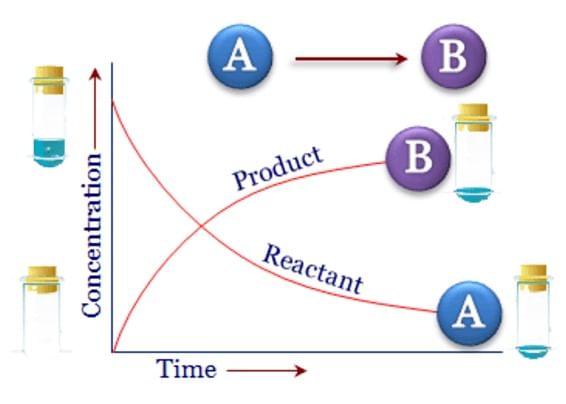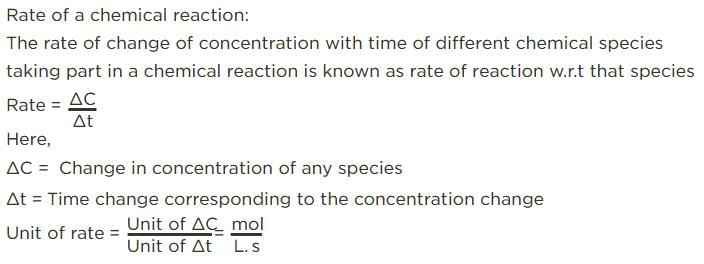Introduction to Chemical Kinetics: Rate, Rate Law & Order | Physical Chemistry PDF Download
Chemical Kinetics
“Chemical Kinetics involves the study of the rates and mechanism of chemical reactions.”
Rate of Reaction
The rate of reaction refers to the speed at which the products are formed from the reactants in a chemical reaction.

Consider a reaction of the form
A + 2B → 3C + D...........(1)
in which the molar concentration of participants are [A], [B], [C] & [D].
The rate of consumption or decomposition of one of the reactants at a given time is where R is A or B. The rate of formation of one of the products is
where P is C or D.
The rate of reaction can be expressed with respect to any species in equation (1).
Thus, the rate of reaction can be defined with respect to both reactants and products.
For example:
4NO2 (g) + O2 (g) → 2N 2O2 (g)
Q.1. Find the expression for the Rate of Reaction.
4NO2 (g) + O2 (g) → 2N 2O2 (g)
Sol:
Rate Law and Rate Constant
The rate of a reaction will generally depend on temperature pressure and the concentration of species involving in the reaction.
The rate of reaction is proportional to the molar concentration of reacting species.
i.e. A + B + C + D + ……. → Product
then, rate of reaction = k[A]a [B]b [C]c [D]d ………..
where [A] is the concentration of reactant A, [B] is the concentration of reactant B and so on. The constant a is known as the reaction order with respect to species A, b the reaction order with respect to species B, and so on.
The overall reaction order is equal to the sum of the individual reaction orders (a + b + c + d + ……..). Finally, the constant k is the rate constant for the reaction.
The rate constant is not only dependent on concentration but also on temperature & pressure.
This relationship is known as a rate law.
Order of the Reaction
A + B + C + ……… → Product
The rate law = v = k[A]a [B]b [C]c ……..
The order of reaction = a + b + c + ……
For example: if rate law = v = k[A]1/2 [B]
Then, it is half order in A, first-order in B, and three half order overall.
Molecularity of a Reaction
The number of reacting species (atoms, ions, or molecules) taking part in an elementary reaction, must collide simultaneously, in order to bring about a chemical reaction is called the molecularity of a reaction.
Relationship between Rate law, Order, and the Rate Constant:
Then, rate of reaction =
The unit of rate of reaction is mol liter–1 sec–1 i.e. mol L–1 s–1.
where M represents mol L–1 or moles per liter & n is the order of reaction.
The unit of rate constant (k)
Rate of reaction = k[A]n
unit of rate of reaction = unit of k × [unit of concentration]n
MS–1 = unit of k × [M]n
⇒ unit of k =
i.e., unit of k = M1 - n S-1 = mol1 - n Ln - 1 S-1
Q.2. Find the order of the reaction if unit of rate constant or the reaction is (dm3)3/2 mol–3/2 s–1.
Sol. Unit of rate constant = (dm3)3/2 mol–3/2 s–1 (given)
We know that,
Unit of rate constant = M1 – n s–1
For nth order
i.e. M1 - n s -1 = (dm3 )3 / 2 (mol)-3 / 2 s -1
∵ 1 L = 1 dm3
&
i.e. it is 5/2 order reaction.
Determination of Order of Reaction
Using the following data for the reaction, we determine the order of the reaction with respect to A and B, over all order and rate constant for the reaction
Sol. A + B → Product
rate of react ion = k[A]a [B]b
5.25 × 10–4 = k[2.30 × 10–4]a [3.10 × 10–5]b ...(1)
4.20 × 10–3 = k[4.60 × 10–4]a [6.20 × 10–5]b ...(2)
1.70 × 10–2 = k[9.20 × 10–4]a [6.20 × 10–5]b ...(3)
Divide equation (2) by equation (3), we get
2.47 × 10–1 = (0.5)a
(0.247) = (0.5)a
(0.5 × 0.5) ≈ (0.5)a
(0.5)a ≈ (0.5)a
or taking log we can find the value of a.
a = 2
Divide equation (1) by equation (2) we get
1.25 × 10–1 = [0.5]a [0.5]b = [0.5]2 [0.5]b
= 0.25 [0.5]b
5 × 10–1 = [0.5]b
⇒ 0.5 = [0.5]b
⇒ b = 1
Therefore, the reaction is second order in A and first order in B, and third-order overall.
rate = k[A]2 [B]
5.2 × 10–4 Ms–1 = k(2.3 × 10–4 M)2 (3.1 × 10–5]M
⇒ k = 3.17 × 108 M–2 s–1
i.e. the over all rate law is
rate = (3.17 × 108 M–2 s–1) [A]2 [B]
|
84 videos|142 docs|67 tests
|
FAQs on Introduction to Chemical Kinetics: Rate, Rate Law & Order - Physical Chemistry
| 1. What is the definition of chemical kinetics? |  |
| 2. What is a rate law in chemical kinetics? |  |
| 3. How do you determine the order of a reaction? |  |
| 4. What factors affect the rate of a chemical reaction? |  |
| 5. What is the significance of the rate constant (k) in chemical kinetics? |  |


















